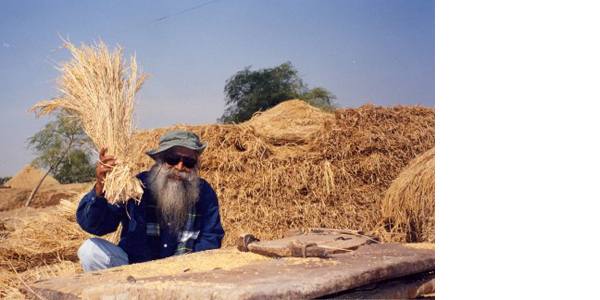Saving India’s Soil Through Better Farming

“If we do not revolutionize our farming in some way, there is simply no way out.”
—Sadhguru
Sadhguru: If you fly from Coimbatore to Delhi, and look down every five minutes, except the Western Ghats, all you will see is a brown desert. This is simply because of senseless agriculture. Today agriculture occupies eighty-four percent of land in India. When we got independence, nearly ninety-three percent of the people were in agriculture. This was not because they were traditionally agriculturists or farmers. If you look back on the history of this country, you will see that two-hundred-and-fifty years ago, we were the largest exporters of textiles in the world. Thirty-three percent of the world's export was from India. Nearly forty to forty-five percent of our country's population was involved in making textiles. We never exported raw cotton, because our cotton is not of great quality. But with that very short staple cotton, and from silk, hemp, jute and just about every kind of fiber, we produced magic in the form of textiles. We evolved over hundred-and-forty different kinds of weaves and did such magical things with it that the world was totally enamored by this produce..
But between 1800 and 1860, our textile exports came down by ninety-four percent. This was not by accident but by design. The British broke the looms, they destroyed the market, they taxed everything three times over and they brought in imported cloth. The British governor general, William Bentinck said, "The bones of the cotton weavers are bleaching the plains of India." Millions of people died of hunger after their livelihoods were destroyed. The rest of them started scratching land to somehow make some living. Subsistence farming happened all over the place.
These were not traditional farmers but people involved in various dimensions of textile industry who desperately went into farming. Over ninety percent of the Indian population was farmers when we got independence in 1947. Today it has come down to seventy percent. This means that seven people are cooking food for ten people. Not very efficient, isn’t it? Because we are scratching every piece of land just to produce very little. If we do not revolutionize our farming in some way, there is simply no way out.
In India, people have been tilling the same land for thousands of generations. But in the last generation, the soil quality is so poor, that it is on the verge of becoming a desert. This is because trees have all been cut and millions of animals are being exported from the country. We must understand, these are not animals - this is our topsoil going to some other country. When this happens, how will you replenish the soil? If you want to preserve the soil, it means organic content has to go into it. If there are no leaves and no animal waste, you cannot put back anything. This is simple wisdom that every farming family knew – how many animals and how many trees you must have on a certain amount of land.
There is a national aspiration which had already been set in the old Planning Commission that thirty-three percent of India should be under shade, because if you want to preserve the soil, that is the only way. And I am trying to push for a law that if you own one hectare of land, compulsorily you must have a minimum of five bovine animals on the land. Otherwise you must be dispossessed of the land, because you are killing the land.
There is one fantastic thing about this land for which we have scientific data but no scientific reasoning yet. If you go to a place where the soil is good in this country and take one cubic meter of this soil, it is said that there are approximately over 10,000 species of life in that one cubic meter. This is the highest concentration of life found anywhere on this planet. We do not know why. So this soil just needs a little support. If you give it that little support, it will bounce back quickly. But as a generation of people, do we have the necessary brains to do that little support or will we just sit around and watch it die?
For example, the Cauvery basin accounts for eighty-five-thousand square kilometers. In the last fifty years, eighty-seven percent of the green cover has been removed. So, I'm taking up Cauvery Calling to revitalize the river. To cover one-third of Cauvery basin, we need to plant two-hundred-and-forty-two crore trees. That means 2.42 billion trees. It is not that Isha Foundation is going to plant this. We want to bring in the movement of agroforestry, showing farmers that this is the best economic module for them.
An average farmer in Karnataka is earning around 42,000 rupees per hectare, in Tamil Nadu about 46,000 rupees per hectare. In the first five years, the average income for five years, we can multiply it three to eight times. Once people see the economic benefit of this, after that you do not have to convince them. They will do it anyway. If everybody converts one-third of their land into agro-forestry, their incomes will be boosted big time and the soil will also get enriched.
Editor’s Note: Cauvery Calling is a campaign to support farmers in planting 242 crore trees and save Cauvery. This will increase water retention in the basin, while improving the income of farmers five-fold. Contribute to plant trees. Visit: CauveryCalling.Org or call 80009 80009. #CauveryCalling


